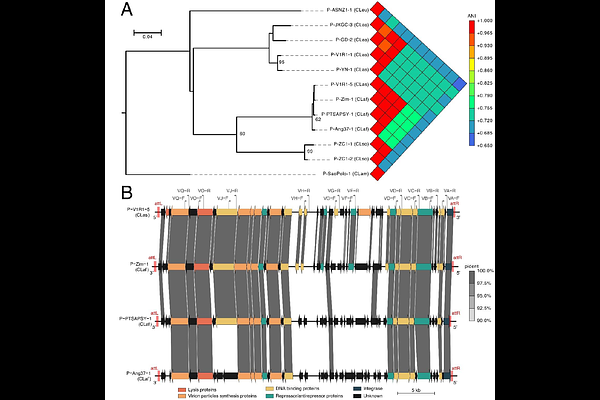Genomic footprint of a shared Type 5 prophage in 'Candidatus Liberibacter asiaticus' and 'Candidatus Liberibacter africanus', two destructive bacterial pathogens of citrus huanglongbing

Genomic footprint of a shared Type 5 prophage in 'Candidatus Liberibacter asiaticus' and 'Candidatus Liberibacter africanus', two destructive bacterial pathogens of citrus huanglongbing
Labbe, F.; Boyer, C.; Clavijo-Coppens, F.; Benoist, B.; Turpin, P.; Ravelomanantsoa, S.; Pruvost, O.
AbstractHuanglongbing (HLB) is a bacterial disease that affects citrus trees and is considered the most severe citrus disease in the world. The three HLB-associated \'Ca. Liberibacter\' species harbor prophage regions which have been described to play critical roles in their evolution and biology. In this study, we assembled and characterized the accessory genome of the first circular de novo \'Candidatus Liberibacter asiaticus\' (CLas) assembly (V1R1) from Reunion, one of the sparse areas worldwide hosting CLas and \'Ca. Liberibacter africanus\' (CLaf). This 1,272 Mb-long whole-genome harbored 1,129 coding sequences and two complete prophages, including a 37,934 bp-long Type 1 prophage, frequently present in CLas genomes, and a 40,501 bp-long undescribed CLas prophage designated as P-V1R1-5. Comparative genomic approaches suggested that P-V1R1-5 have all the genetic elements to produce new viral particles and revealed that it likely belongs to a new CLas Type 5 prophage. While being reported for the first time in a CLas strain, P-V1R1-5-like prophages were previously identified in CLaf genomes, making it the first evidence of shared prophage-like sequence among HLB-associated \'Ca, Liberibacter\' species. Using PCR amplifications targeting P-V1R1-5, we also showed that 85.7% of the tested CLas strains from Reunion and all tested CLaf strains from Madagascar and Reunion harbored a Type 5-like prophage. The identification of CLas Type 5-like prophages not only expanded our knowledge of CLas genomic diversity in Reunion, but also provided new insights into the role of horizontally transferred elements in the evolution of the sympatric HLB-associated bacteria.